|
|||||||
|
projects I MISS MY ENEMIES performance bios past collaborations records fuel museums old small photos order fictcrit |
Venice Biennial 2011
I MISS MY ENEMIES
group show
|
||||||
|
I MISS MY ENEMIES Collateral Event of the 54th International Art Exhibition – Biennale di Venezia 1 June - 1 July 2011 Opening 1 June 2011 Location: Sala del Camino, former Monastery SS. Cosma & Damiano, Giudecca, Venice Presented by The Palaces of the Russian Museum Restoration Fund in partnership with Art Apart, supported by the Odessa Sessions Foundation, Art & Space Gallery, Ter et Bantine and Bernardini Luxury Vintage. We also thank the City of Venice for the precious support. Curator: Oxana Maleeva (below, in empty space of the Sala del Camino before show) 
The show includes video and sound installations, paintings, prints, sculptures and performances by the artists: JOTA CASTRO MARC VINCENT KALINKA STEVE PICCOLO BABI BADALOV ADRIAN PACI BERT THEIS KIRILL CHELUSHKIN 
(left to right: Roberta Busechian, Bert Theis, Steve Piccolo, Gak Sato) Last chance to see/hear: I MISS MY ENEMIES Venice Biennale-54th International Art Exhibition- 2011 THE END: 1 JULY 2011 7.30 PM with performances by Roberta Busechian, Cecilia Borettaz, Gjoke Gojani (unofficial virtual Kosovo non-pavilion!) Location: Sala del Camino, ex-monastery SS. Cosma e Damiano Giudecca, Venice, Palanca stop 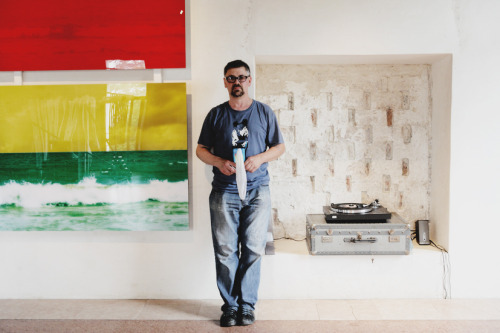
(Marc Vincent Kalinka with two of his works) Ivan Karamazov (F. Dostoevsky) on I MISS MY ENEMIES: "I don't want harmony. From love for humanity. I don't want it. I would rather be left with the unavenged suffering. I would rather remain with my unavenged suffering and unsatisfied indignation, EVEN IF I WERE WRONG. Besides, too high a price is asked for harmony; it's beyond our means to pay so much to enter on it. And so I hasten to give back my entrance ticket, and if I am an honest man I am bound to give it back as soon as possible. And that I am doing. It's not that I don't accept God, Alyosha, but I most respectfully return Him my ticket." 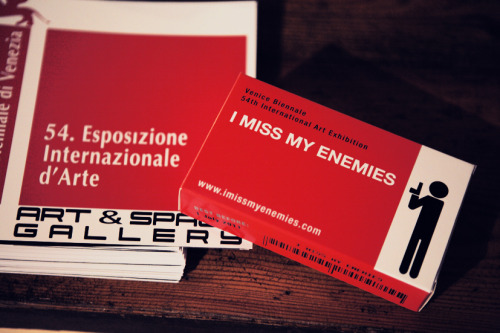
(I MISS MY ENEMIES catalogue: a pharmaceuticals box complete with user information leaflet on ENEMIES). Glenn O’Brien on I Miss My Enemies (found contribution to endlessly open catalogue): “Ego has a bad name, worse in some circles than in others. […] In many psychologies 'I' is the enemy. From acid heads to Esalenites the subject of consciousness is the object of elimination. Egoism, egotism, all that begins with I is suspect of 'subjectivity,' a cardinal sin in this scientific age. The 'editorial we' became a popular euphemism for I (where no other substitute was available) not so much to suggest strength in numbers as to avoid the stigma of the solo subject. But is I so anti-social, so rude that it deserves to be so roundly discredited? l think not—therefore I am.” 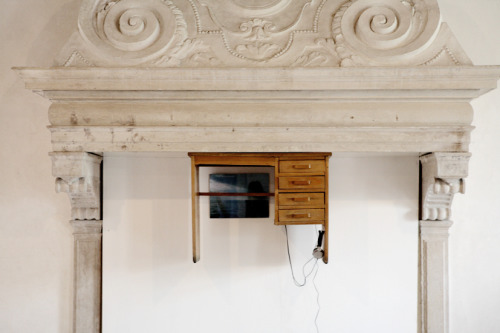
(Installation 'The Bell' by Steve Piccolo) From endlessly open press release: "Can enmity evolve into friendship? The mystique of propagandized menace. Declaration of enmity as a first step towards new understanding. Frightening enemies of childhood, real or imagined enemies of today." 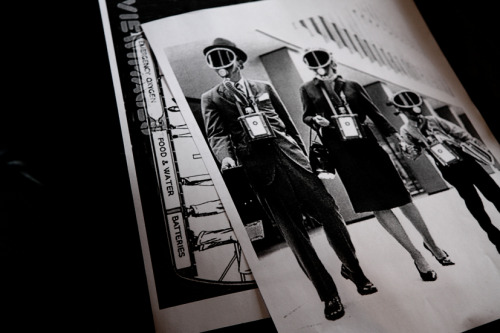
(Photocopied materials from endlessly open catalogue scattered on Bernardini Luxury Vintage furniture around the exhibition.) THE BELL (by Steve Piccolo, from LP Domestic Exile, 1982) There's a fallout shelter in my mind Where I can go when danger is near You can say whatever you want I won't hear you My head is much too big My skull too thick To penetrate my sanctuary from debate Till I get sick of being alone And pick up my red phone to call a truce But what's the use? 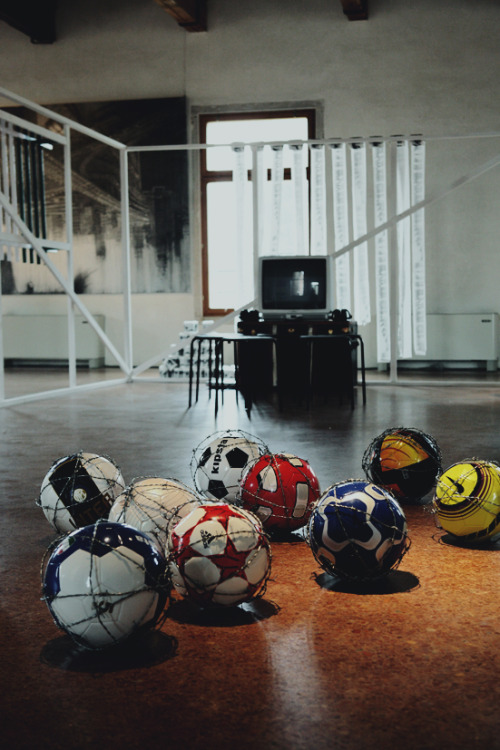
(Tricky by Jota Castro with video by Bert Theis, toilet paper scrolls by Marc Vincent Kalinka, glimpse of very large drawing by Kirill Chelushkin.) (From the endlessly open catalogue, box idea by Marc Vincent Kalinka, texts by Oxana Maleeva and Steve Piccolo): "An era of emphasis on programmed friendship that guts the term of meaning. Pervasive social network language that lets you “like” but not “dislike”, share but not conceal. A transient plane of contact where it is forbidden to have enemies. Terms lose meaning without opposites. Writers decree the downfall of ideological systems. But isn’t an anti-ideological stance an ideology itself, sneakily posing as objectivity? The most striking Wikileaks revelation was that under the rhetoric of international amity operative modes of prejudice, political incorrectness, nationalism and ideology live on. Could open statement of enmity be a first step towards understanding? Could taking sides clarify crippling ambiguities of a society (and art world) whose claim to accomodate all expressions deprives them of force? Propaganda changes its approach, flaunting staged controversy to justify media servitude. Increased information/disinformation flow reveals the daunting complexity of the world, raising doubts about the identity of the forces involved. Who is really the enemy? Opinions vary, no clear analysis seems to be available in spite of great verbal expenditure. Hollywood romcoms endlessly reworked the fated love story fraught with misunderstandings and defensive posturing, teaching us a moral: opposites attract, debate makes energy. Take sides. During the Cold War we always had the suspicion that our enemies had to be really cool and interesting, if only because so many idiots seemed to hate them. But today the enemy is hidden, ambiguous, maybe even imagined. “We have met the enemy and he is us” said Pogo, via Walt Kelly, regarding our willful destruction of our planet. An awareness that sounds like maturity but can lead to paralysis. I miss my enemies… and maybe they miss me." 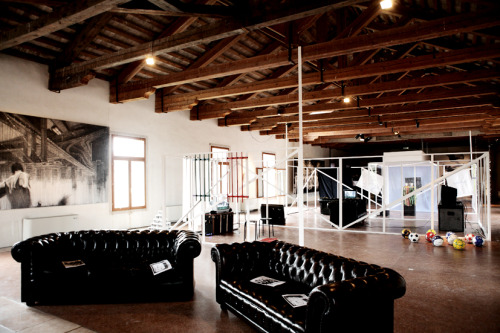
(Overall view of show with furnishings by Bernardini Luxury Vintage) special event at finissage: UNOFFICIAL VIRTUAL KOSOVO NON-PAVILION Curator: Oxana Maleeva (organization by curating agency Art Apart), coordination by the artist Gjoke Gojani. Venice Biennale 2011 hosted at the finissage of the collateral event: I MISS MY ENEMIES THE END: 1 JULY 2011 7.30 PM with COINCIDENTAL contributions by Roberta Busechian, Cecilia Borettaz, Gjoke Gojani (Unofficial Virtual Kosovo Non-Pavilion) Location: Sala del Camino, ex-monastery SS. Cosma e Damiano Giudecca, Venice, Palanca stop 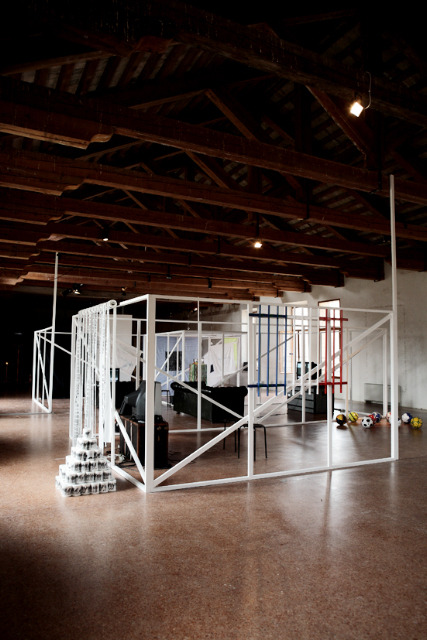
(Another general view of show) illumiNATIONS (more musings from endlessly open catalogue) When Biennale director Bice Curiger chose the theme “ILLUMInations” for 2011 the accent seemed to be on light, and only secondarily on nations, a term she described as a “spurious suffix” in her introduction to the show. She went on to say that “far removed from culturally conservative constructs of ‘nation’, art offers the potential to explore new forms of ‘community’ and negotiate differences and affinities that might serve as models for the future.” In practice, the accent seems to have shifted, though, to “illumiNATIONS”. This Biennale reflects an explosion of different interpretations of national participation, from the presence of a Catalan pavilion to first-time participations and countries returning after a long hiatus, including Haiti, Iraq, Andorra, Saudi Arabia, Bangladesh, India, Moldova. The United States is represented by two artists from Puerto Rico, and artists of the Roma ethnic minority have their own show, a collateral event, for the second time in Venice. Many countries have chosen to be represented by artists and/or curators not living on national soil or even not belonging to the nationality they represent, in a sort of transnational mash-up that runs the risk of totally confusing Venice’s particular characteristic as a biennial of national pavilions and has often underscored the presence of dissent and controversy about identity, jibing nicely with Curiger’s accent on “fragmentation” and “temporary alliances”. 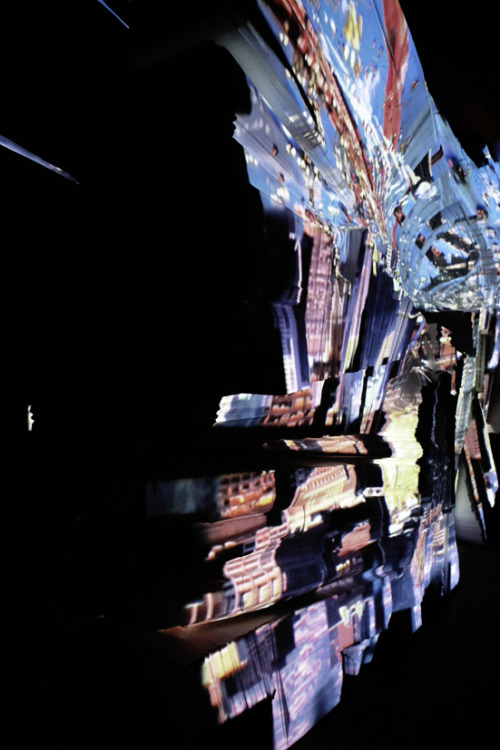
(Upside-Down City by Kirill Chelushkin, video projected on large shaped screen) Related project: Transnistria Pavilion (endlessly open catalogue cont.) One of the most interesting and somewhat “clandestine” stories in this context is that of the participation of Moldova, a pavilion that split into two locations, one for a more “official” representation of the country, and one representing a secessionist fragment of it, called Transnistria, a small zone that has its own currency and border controls, yet is officially recognized by only two other countries. The pavilion of Transnistria, a project curated by Oxana Maleeva in her role as part of the Moe Art Group with Mark Verlan, Aliona Kononova and Igor Avramenko, is a colorful shack erected outdoors at a gondola repair yard, right at the edge of the water, and it has attracted a great deal of attention on the busy walk from the Zattere to the Accademia bridge. 
(Transnistria Pavilion by Moe Art Group) Related project: Virtual Kosovo Pavilion Combining the idea of a “clandestine pavilion” pioneered by Sislej Xhafa, an artist from Kosovo, back in 1997, and the approach of Miltos Manetas two years ago with his “internet pavilion”, artist Gjoke Gojani (also from Kosovo) has created an “unofficial virtual Kosovo non-pavilion” by inviting artists from his country, many of whom live elsewhere around the world, to contribute works that can be experienced in digital form on a computer monitor. After he was asked by Steve Piccolo, the American sound artist and Gojani’s former teacher, to make some kind of contribution to the ending event of the collateral exhibition at the Biennale entitled I MISS MY ENEMIES (also curated by Oxana Maleeva), their conversation drifted toward the idea that Kosovo should have a virtual pavilion, and that Gojani should contact many outstanding young Kosovo artists, forming a network to set a very unofficial but interesting precedent, hopefully a harbinger of bigger and better things to come. |
|
||||||
